If the ceiling slabs in the kitchen are of different levels, and also have slits and irregularities, then the use of plasterboard ceilings will be the most successful solution.
In addition, it will help in solving the problems associated with the laying of communications, and you will have the opportunity to create an interesting lighting scheme. In addition, it is possible to form the most diverse designs of gypsum board ceilings in the kitchen – oval, straight, bent and even round.

Plasterboard ceilings in the kitchen
They are perfectly combined with any interior styles, and can be used to solve various problems of a technical or aesthetic nature.
Advantages and disadvantages of using gypsum board ceilings in the kitchen
At the heart of gypsum plasterboard is gypsum, on top of which cardboard lining is applied, as a result of which this material is completely environmentally friendly. To complete the installation of this design will take from one to three days, depending on the size of the kitchen and the complexity of the picture. However, in any case, an ideally smooth, beautiful and durable ceiling will be obtained at the output.
Benefits:
- Using a moisture-resistant drywall allows you not to think that humidity or temperature drops will harm it.
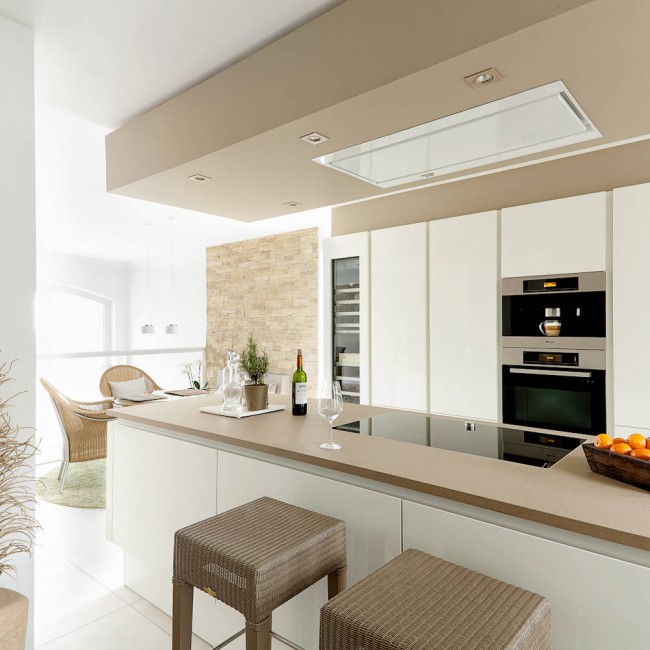
The ceiling of gypsum board is resistant to temperature changes
- Also, such designs are ideal for hiding various communications.
- The uneven foundation of the ceiling is also easily hidden behind the plasterboard ceiling, and it does not need to be leveled.
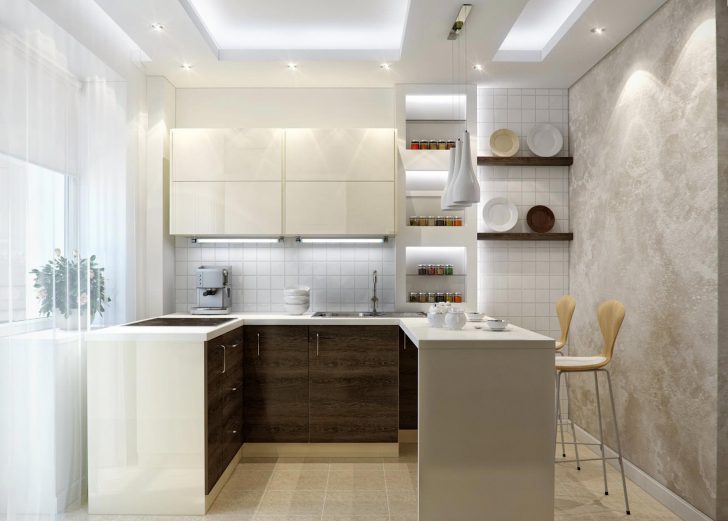
The construction of gypsum board will hide all the irregularities of the ceiling
- The procedure for zoning the kitchen is simplified.
- Heat and sound insulation can be laid in the niche between the plasterboard and the main ceiling.
- Ease of installation. Drywall can be used to form absolutely any structures, as a result of which even the most daring design solutions can be implemented. In addition, the procedure for installing luminaires in such ceilings is simplified.
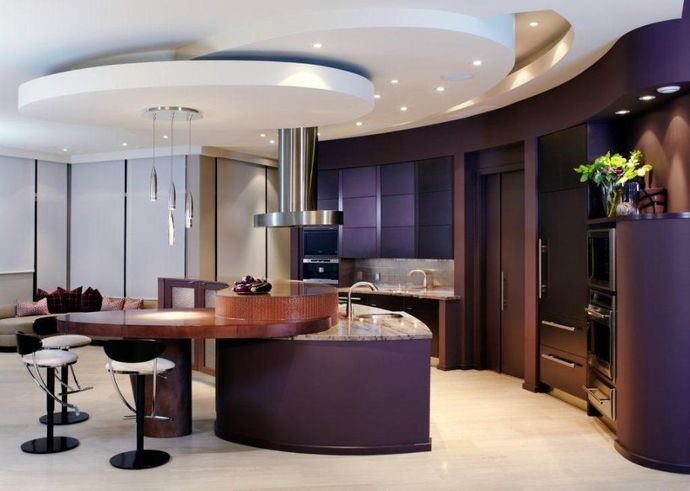
Drywall will allow to make any design
- Easy maintenance, if necessary, it can easily be painted in a different color.
- Resistance to mechanical damage. It’s clear that heavy objects can damage it, but the sheet can easily be dismantled and installed a new one.
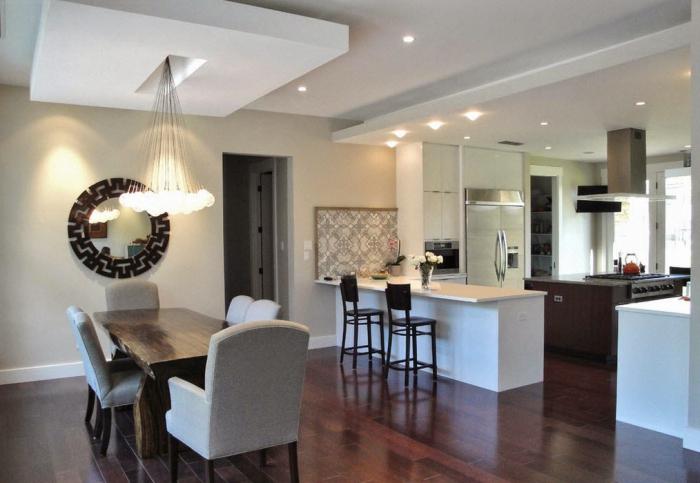
Plasterboard ceilings are resistant to mechanical damage
Disadvantages:
- The installation process itself is not recommended, since the presence of even a minimal error in the design can lead to the formation of cracks.
- To conceal the joints, the paintwork should be as neat as possible.
- Owners of apartments in new buildings must refrain from installing plasterboard ceilings in the kitchen and other premises, since after shrinking the house, the skeleton of the ceiling may warp, and cracks form on it.
Consequently, in the kitchen it is possible to use ceilings from plasterboard. In addition, they can be combined with other, highly popular, tension structures.
What are the designs of plasterboard ceilings
It is necessary to determine the ways of fixing gypsum boards to the ceiling.
- Suspended way. First of all, a suspension system is attached to the ceiling, represented by brackets, rods, thick wire. After this, the metal frame is fastened to which plasterboard sheets are subsequently mounted. This method allows, using the height of the hangers, to regulate the level of the location of ceilings from plasterboard in the kitchen.

Construction of suspended ceiling from gypsum board
- Sheathed. It is characterized by the fastening of the frame directly to the slabs, which makes it possible to increase the rigidity and strength of the structure.
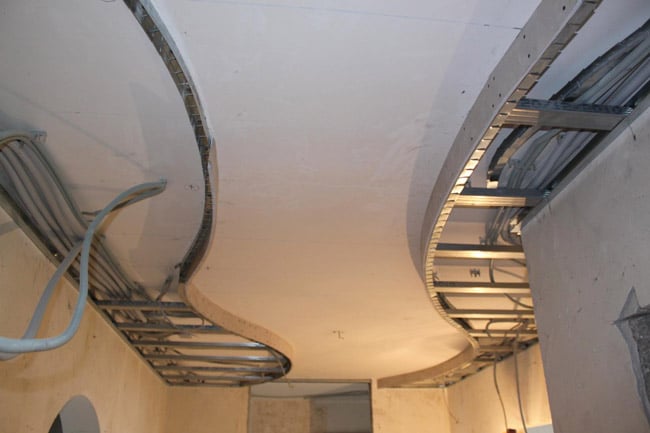
The construction of the ceiling made of plasterboard
- Combined. In this case, both the pendant and the filing method are used. Most often this variation occurs during the arrangement of multi-level ceilings.

Combined ceiling of plasterboard in the kitchen
Combination of different materials is allowed. For example, the box can be plasterboard, but you can use a tree to trim the central part of the ceiling. This solution is suitable for kitchens designed in the style of loft or country.
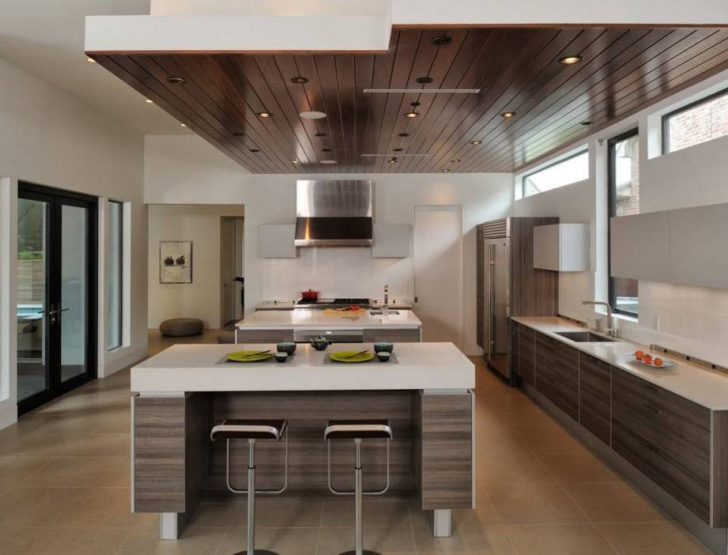
Combined false ceiling in the kitchen
Modern styles differ the use of combined ceilings, when a combination of plasterboard and stretch ceilings is carried out.
One-level gypsum plasterboard ceilings in the kitchen
This design is very simple, and can be used in any premises. It is allowed plastering and subsequent painting, as a result of which the ceiling will be virtually indistinguishable from the traditional, without losing its own advantages.
Also in the niche between the ceilings may be located communications, wiring or installed luminaires.

One-level gypsum plasterboard ceiling in the kitchen
To emphasize the visual zoning of the kitchen can be applied a different color or a different texture over the areas requiring separation. For example, you can use saturated tones to highlight the working area, but the area of the dining table is painted in lighter colors. This color will attract attention to the dining area, which will dominate the interior.
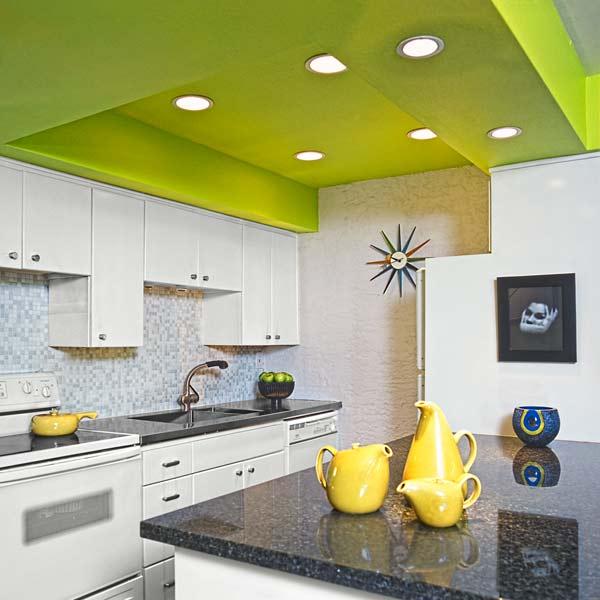
Zoning kitchen with colored ceiling from gypsum board
In addition, it is possible to distinguish areas in the kitchen with plasterboard ceilings using luminaires, which should be located along the boundaries of these zones. If the light is directed downwards, then there will be a kind of “light curtain”, through which it will be possible to effectively allocate various zones in the kitchen.
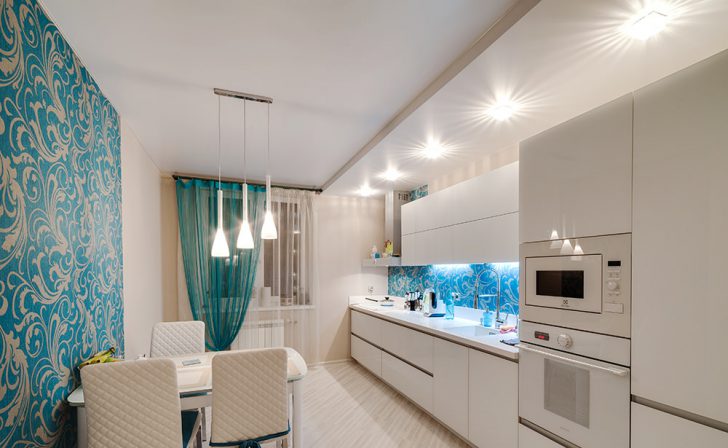
Zoning space with lighting
The use of three-dimensional drawings in the design of the plasterboard ceiling in the kitchen will make it a real masterpiece. At the same time, it is quite possible to fulfill them independently. You just need to choose the most liked pattern, draw it using liquid paper, and dry it. In the future, the gypsum boards are reinforced at the locations and their coloring is in the usual form.
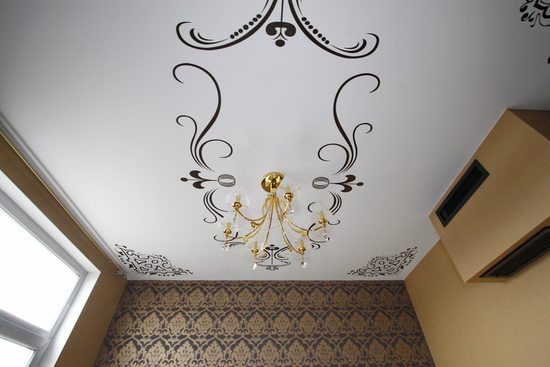
Picture on the ceiling of plasterboard
Two-level ceilings from plasterboard in the kitchen
If two levels are used during the execution of the design, then this gives great opportunities to get a harmonious interior, as well as solve technical problems. Thanks to the protruding parts, it will be possible to conceal large elements of communications.
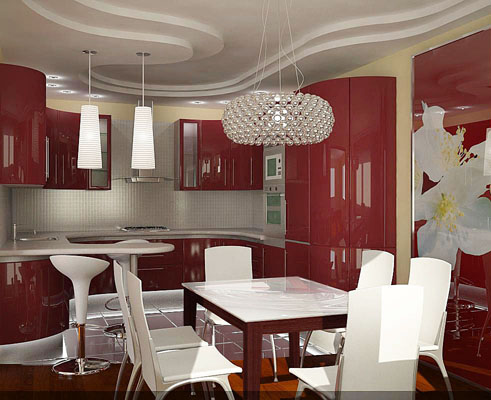
Two-level ceiling of plasterboard in the kitchen
Also, if you use different parts of the height, the room becomes visually not only more voluminous, but it also contributes to the solution of interior tasks. Most often, higher structural elements are located in the central part of the kitchen or above the working area. Their shape largely depends on the overall design, and can be quite diverse. The combination of oval and rectangular elements is not infrequent for the design of the plasterboard ceiling in the kitchen, in addition, you can see the design solution, in which a combination of gypsum plasterboard elements and stretch ceilings occurs. Thanks to such solutions, the interior becomes more diverse and gets a certain “zest”.
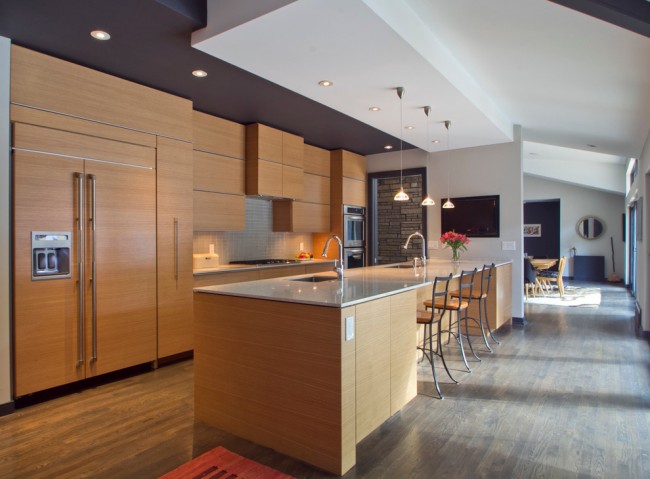
The form of a two-level ceiling depends on the interior of the kitchen
Multi-level gypsum plasterboard ceilings in the kitchen
Calling ceilings, using elements of plasterboard structures, which are located on three or more levels, is called multilevel. This type of arrangement of the ceiling is used in cases where the kitchen is very spacious, and the height of the ceiling is 3 or more meters.
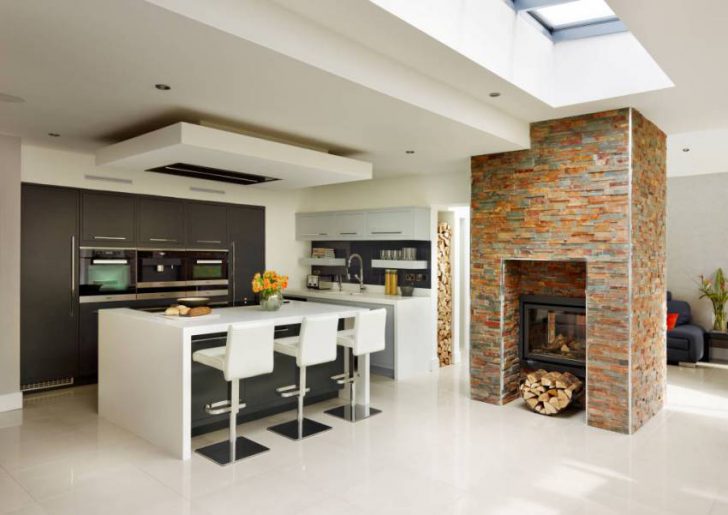
Multi-level ceiling from plasterboard in the kitchen
Most relevant this solution will be for apartments of old construction, where the ceiling height is more than 4 meters. Considering the fact that such a premise is not large in area and its height is huge, it looks disproportionately on the outside, and with the help of multi-level ceilings from plasterboard it is possible to correct the proportions of the kitchen.
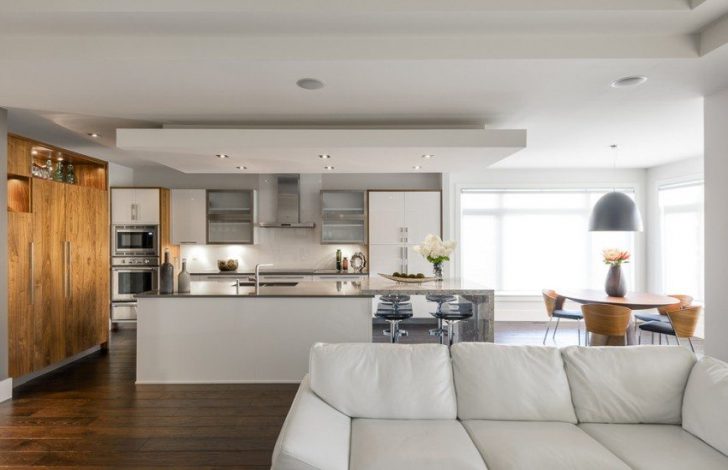
Multi-level design suitable for kitchen with high ceilings
With the help of such ceilings, it is also possible to conceal serious differences in altitude, ceiling defects, and hide boxes and beams.
Plasterboard ceilings in the kitchen with lighting
If the color schemes are selected correctly, the room can be radically changed, it will become more spacious. For ceiling mounted spotlights, you can note the possibility of performing the role of the main lighting.
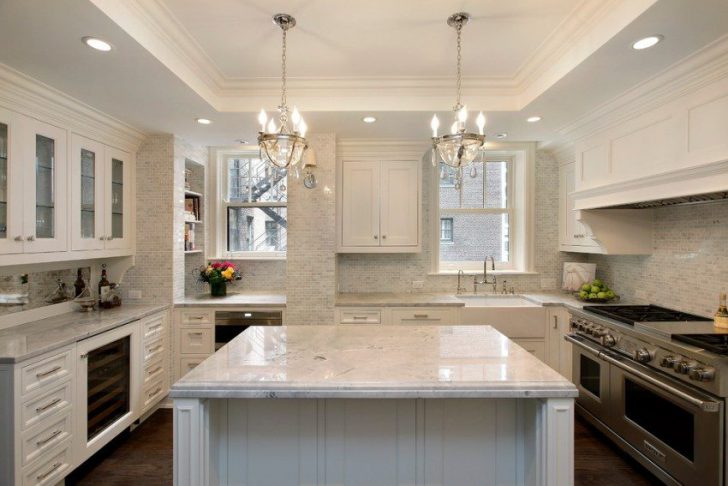
With lighting, you can adjust the kitchen space
We can not but mention the cornice illumination of the ceiling, organized by gluing the cornice on the wall, retreating from the ceiling for a couple of centimeters, behind which the LED strip is mounted. It is possible to change the power and color of such a backlight.
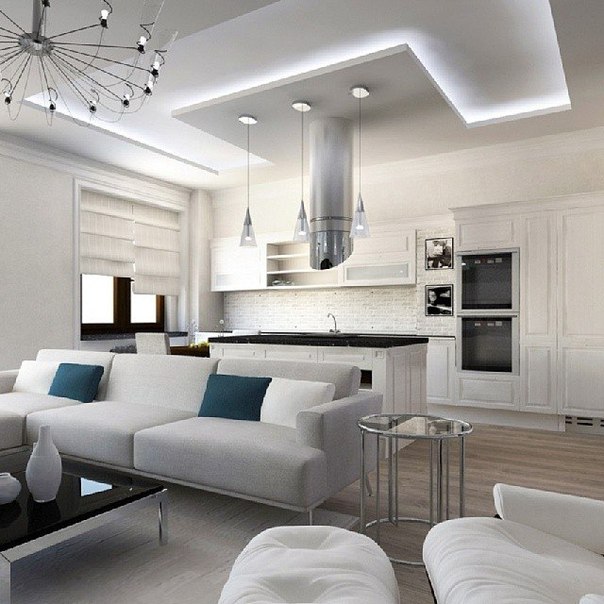
Cornice illumination of plasterboard ceiling
Design of drywall ceiling for kitchen
“To visually emphasize the zoning make a choice in favor of a split-level ceilings from plasterboard for the kitchen: above each of the zones they must be at a certain height”
Before starting the process of designing the structure of gypsum board, it is necessary to take into account some technical requirements. For example, above the equipment located in the working area should be located duct. The luminaires should also be built in accordance with the distance between the ceiling and the gypsum board structure.
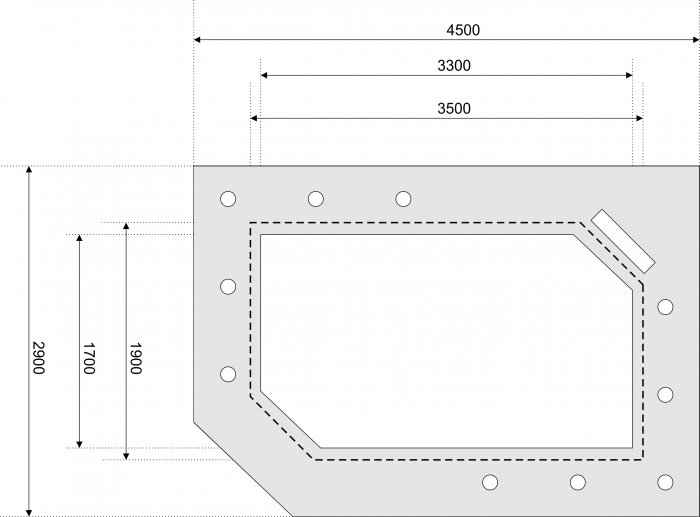
Example of a drawing of a ceiling for plasterboard for kitchen
First of all, you need to estimate the size of the room and the shape of the ceiling. After that, there is a determination of the number of levels and how they will be located, starting from the style and functionality.
The next stage involves choosing the color and method of finishing the ceiling surface, then you need to think about what lighting devices and decor elements will be used for.
The form of ceilings from plasterboard allows not only to emphasize the style of the interior, but also to achieve a visual change in the shape of the kitchen.
- If the kitchen is square, then you can use a rectangular shape, through which the visual stretching of the room. It can be in the middle of the room, and with its help you can select a part of the ceiling, under which is a kitchen island or a bar counter.
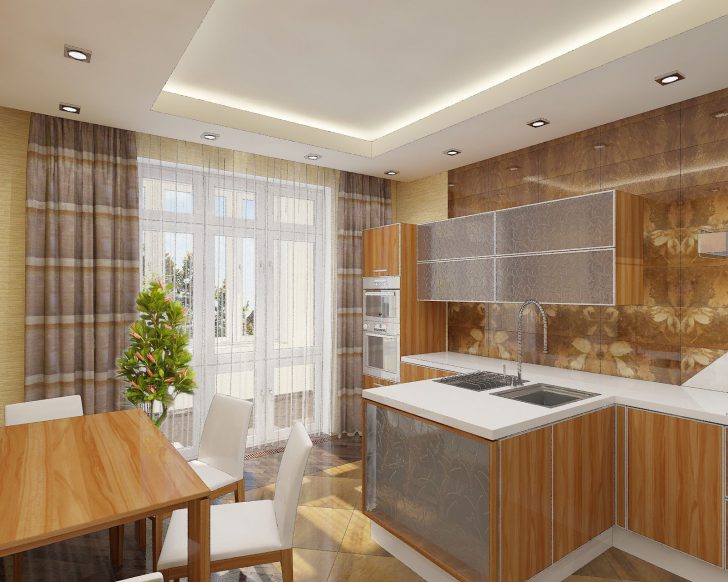
Rectangular ceiling from gypsum cardboard in the kitchen
- If the room is narrow and stretched, then the location above the dining area of a square gypsum plasterboard structure will help to correct the room, and also to focus attention on this zone.

Dedication of the dining area with the help of a gypsum board ceiling
- Accent attention to the center of the kitchen is done using a ceiling in the shape of an oval.
- To visually increase the height of the room, a “floating” ceiling can be used, the main difference being that the drywall sheets do not fit in front of the walls, but along their perimeter there are lamps.
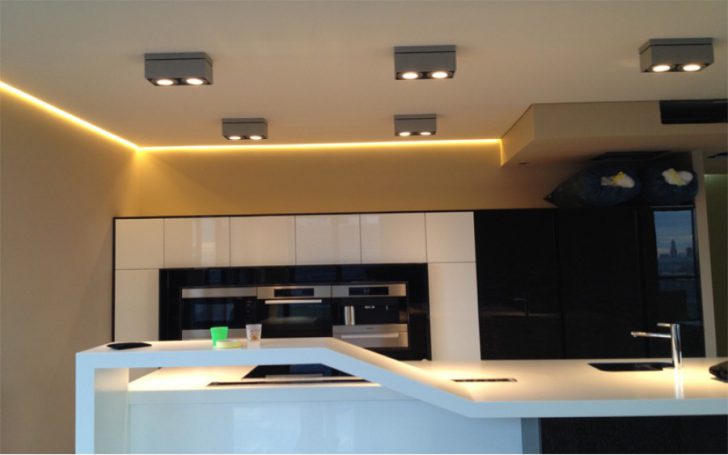
“Soaring” ceiling of plasterboard in the kitchen
It is necessary to take into account the need for the forms used in the drawings on the ceiling to be repeated in the interior. If the furniture will have strict rectangular lines, and on the ceiling there will be smooth and curved bends, this combination will look sloppy and inorganic.
Completeness of the interior will give the presence of a ceiling pattern on the wall. For example, a very interesting solution is in wavy lines that smoothly flow from the ceiling to the wall. If a semicircular ceiling is used above the work area, then it can be repeated below, using, for example, a semicircular island.
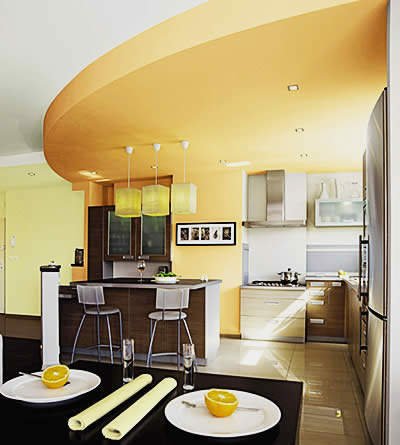
Smooth transition between the ceiling and the wall
To visually emphasize the zoning make a choice in favor of multi-level ceilings from plasterboard for the kitchen: above each of the zones they must be at a certain height. To enhance the effect, you can arrange spotlights along the boundaries of these levels.
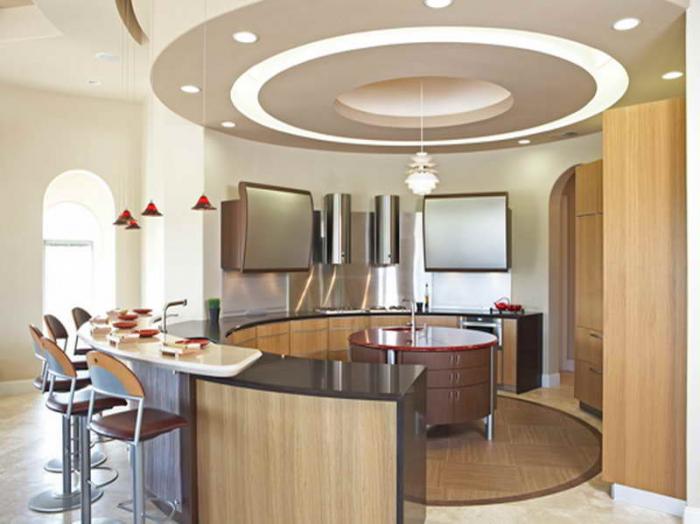
Multi-level ceiling from plasterboard in the kitchen
However, it is still necessary to understand that first of all plasterboard structures are formed in the kitchen proceeding from its functional needs: the box should be located above the working area, where the main communications will be hidden. Often it plays the role of a starting point during the construction of the entire structure. This zone is characterized not only by the lowering of the ceiling level, but also by the use of point lighting, which harmoniously complements the working area.

Organization of work area lighting
Choose the color you need based on the general rules of design. The design of the plasterboard ceiling in the kitchen should take into account the following points:
- if the room is small, give preference to light colors;
- if the kitchen is large in area, then it will look great in saturated dark shades;
use of pastel tones allows you to add coziness;
- the use of bright, harsh colors can negatively affect the mood and well-being.
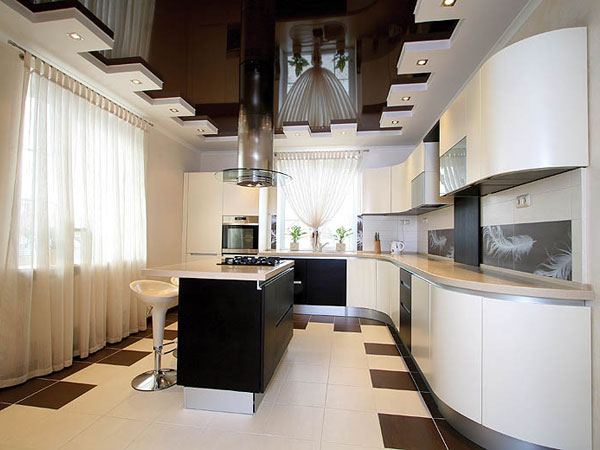
Decoration of the ceiling from plasterboard in contrasting colors
Paint choice
Drywall is a very versatile material that can be painted, wallpapered, plastered, etc. after installation.
Considering that we are talking about the kitchen, where cleaning of the premises is carried out quite often, it is necessary to give preference to painting. Let’s get acquainted with the most preferred variants of paints:
- Water emulsion – the most accessible from a financial point of view. Their use makes it possible to achieve the brightness of the ceiling, but the paint’s color and the bad effects of moisture make it necessary to repaint the ceiling quite often. Among the advantages of water-based paints is also called the presence of a huge number of color solutions.
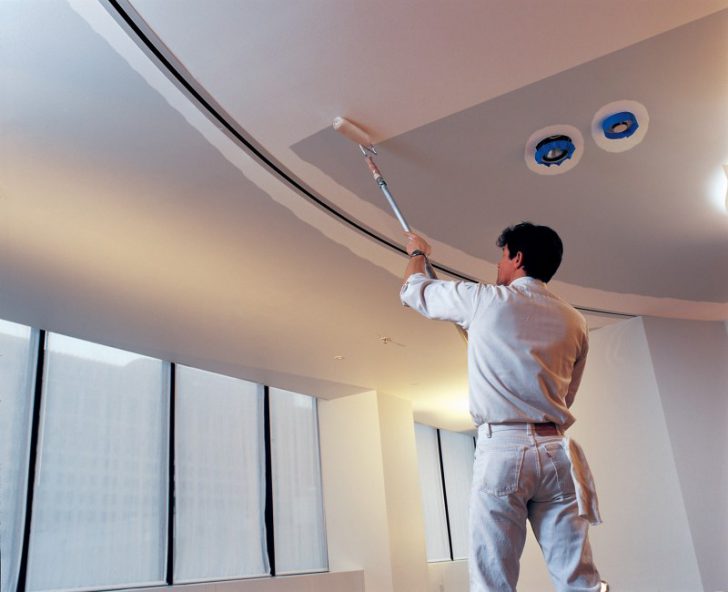
It is easy to choose the water-based paint of the required shade
- Water-dispersive paint differs in moisture resistance and in that it is difficult to wash it off. To clean this ceiling, you can use a damp cloth;
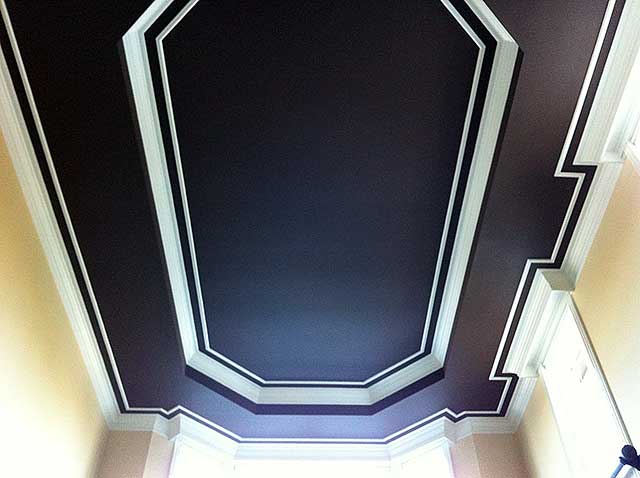
Water-dispersive paint has a moisture resistance
- Paints with acrylic or latex base. The use of such paints makes it possible to form a plasterboard ceiling covering in the kitchen, which will be resistant to steam and moisture, and its surface can easily be washed;
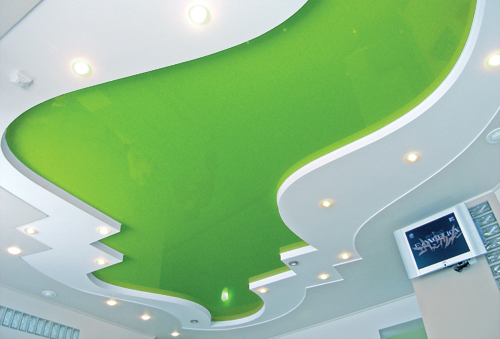
Ceiling painted with acrylic paint can be washed
- Silicate paints also differ in moisture resistance, in addition, during its use, you can do without antiseptics;
- The best characteristics that are inherent in acrylic or silicate paint are contained in silicone paints, which differ in plasticity, can cover cracks of 2 mm, and form a strong protective film.
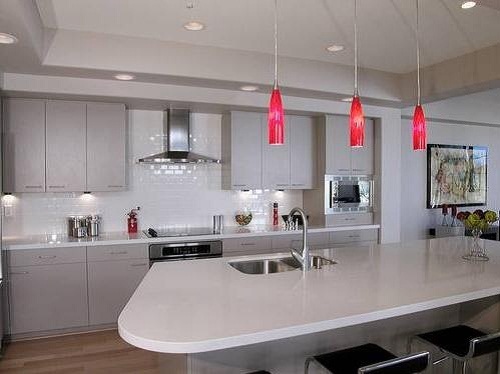
Silicate paint forms a dense protective film
It is necessary to take into account how the colors will be combined with the style of the interior.
Plasterboard ceilings for small kitchens
If the area of the room is small, this will not interfere with the use of plasterboard on the ceiling. It is only necessary to correctly select the type and design of plasterboard ceilings in the kitchen.
- If the kitchen is small in height, then one should prefer single-level ceilings;
- for its complication and increase in efficiency you can use a carefully thought-out light scheme or a variant with a cornice backlight;
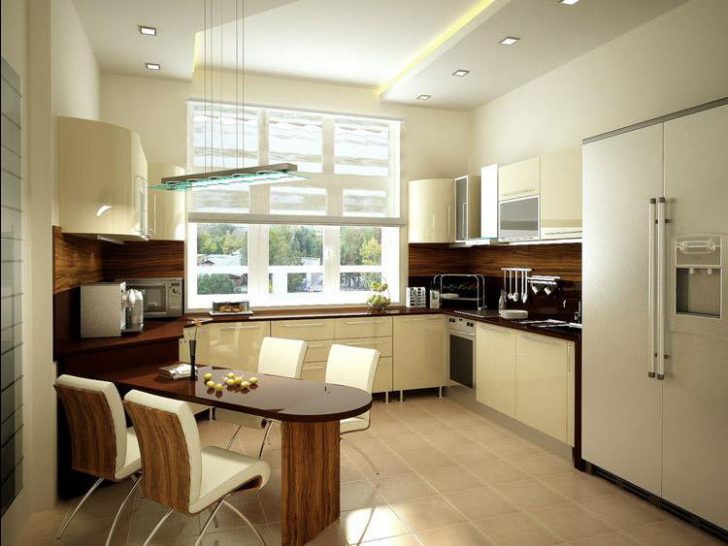
Effective corrugated ceiling lighting from plasterboard
- use of light colors during the coloring of the ceiling allows you to achieve a visual increase in the kitchen;
- but the volume is visually increased due to the use of glossy textures.

Glossy ceiling will add volume to the kitchen
With a small ceiling height and the desire to get a two-level ceiling, it is possible to supplement a conventional single-level ceiling with a wide cornice located slightly below the main level.
Tips and advice from specialists
“If the kitchen is made in a classical style, then the finish and design of the plasterboard ceiling in the kitchen should also be restrained”
- If the ceiling is low, then multilayeredness and complexity should not be used.
- Correctly selected basic form for this type of ceilings allows you to achieve a visual change in the shape and size of the kitchen: the use of a rectangle allows you to “pull out” a square room, and the oval – to focus on its center.

The ceiling of plasterboard in the kitchen of a round shape
- The selection of thematic zones in the kitchen is achieved by properly located lighting.
- Giving the style and efficiency of the kitchen is achieved through the introduction of LED lighting, a special effect from which can be achieved in the dark.
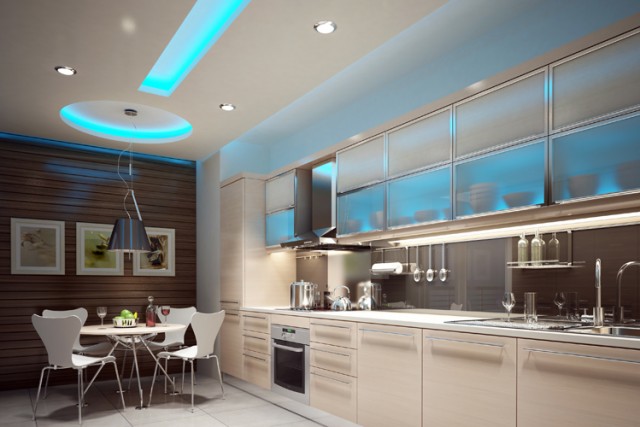
LED ceiling light from plasterboard
- If the kitchen is made in a classical style, then the finish and design of the plasterboard ceiling in the kitchen should also be restrained, in this case it is recommended to prefer matt colors.
- Particular attention should be given to the correct installation of lighting devices, as well as the competent determination of the brightness necessary for them.
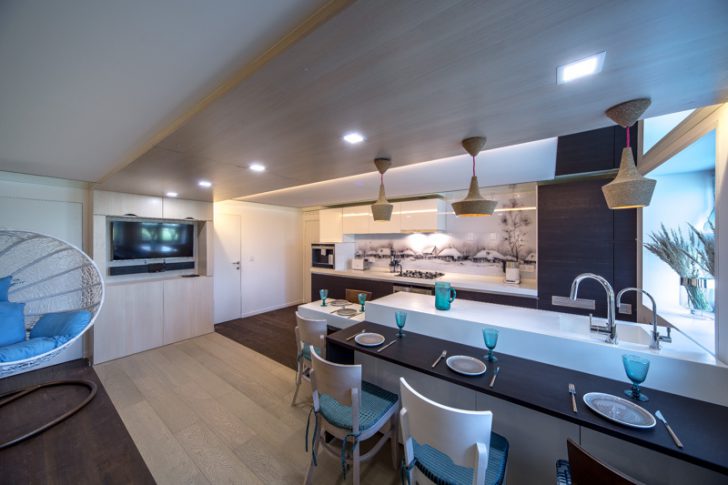
It is very important to properly install the ceiling lighting
Conclusion
During the arrangement of design in the kitchen with the help of plasterboard ceilings, you have the opportunity to realize all your most interesting ideas, and maximize your own potential. The composition of unique designs can include various shapes and patterns: from standard rectangular or square to oval. This is all possible due to the fact that gypsum board is not only very easy to handle, but also has a high level of resistance to various influences. Therefore, after the decoration of ceilings from gypsum board, even the smallest kitchen can turn into a room with a bright individual design.
Photo gallery – plasterboard ceilings in the kitchen
Video
Author: Mikhail Bond

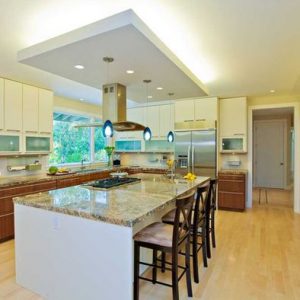
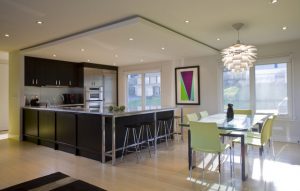
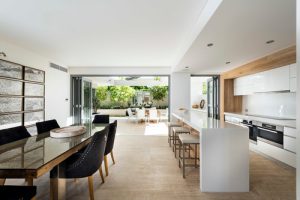
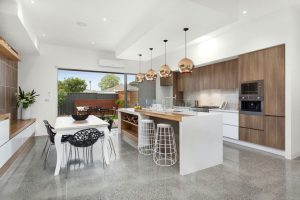
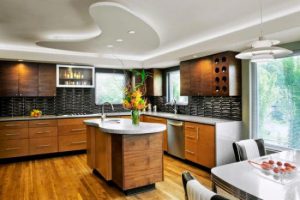
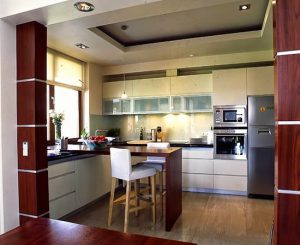
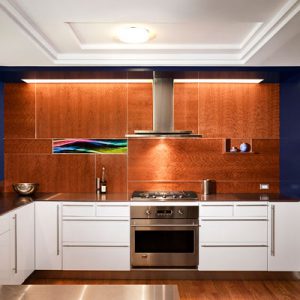

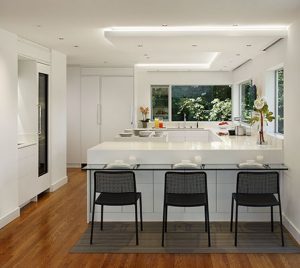
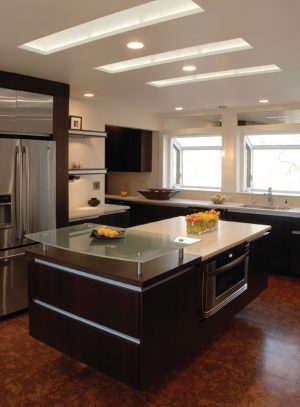

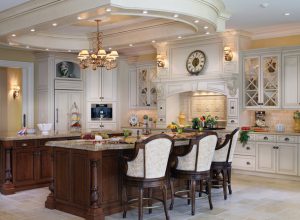
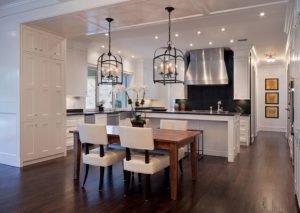
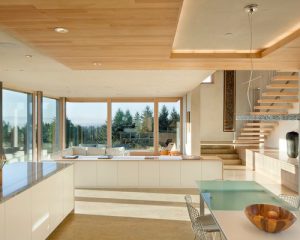

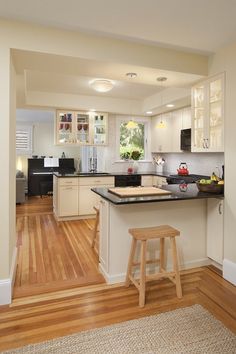

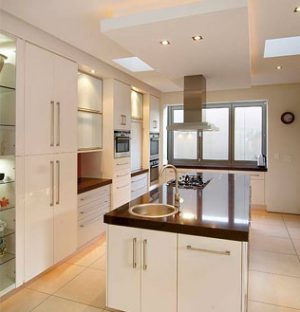
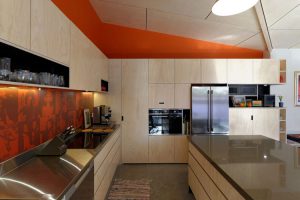

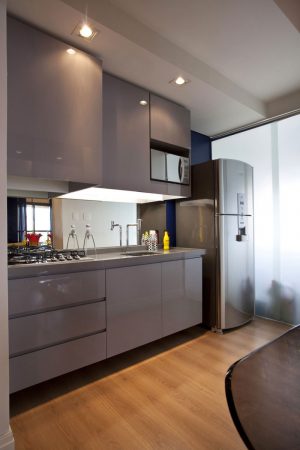
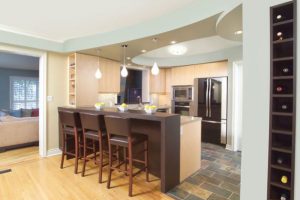
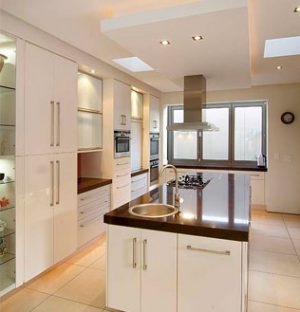
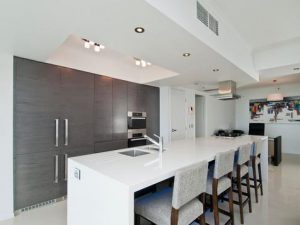
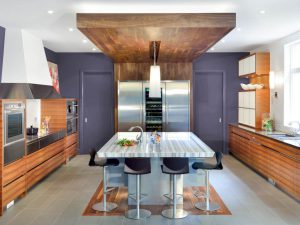
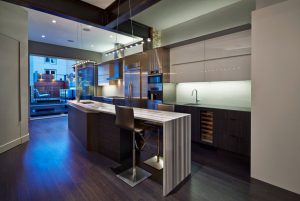


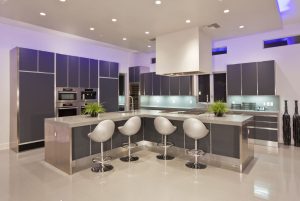
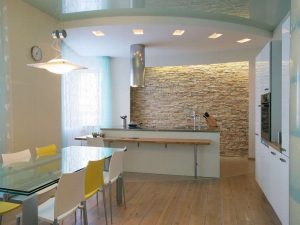
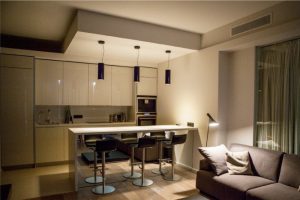
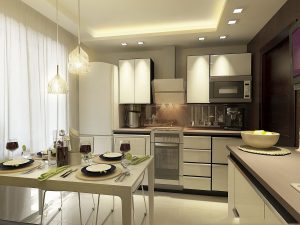
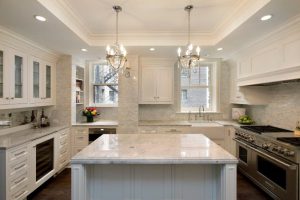
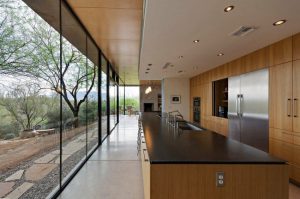

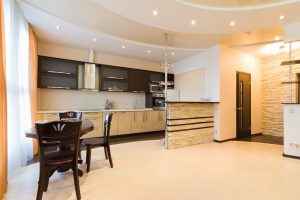
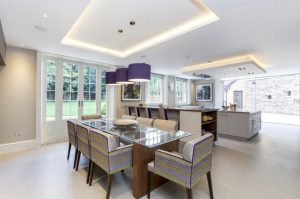
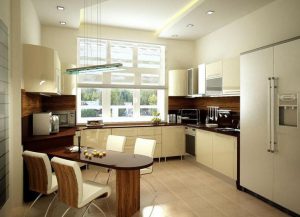
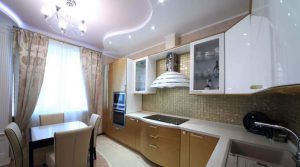
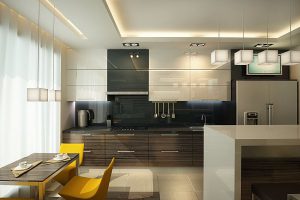

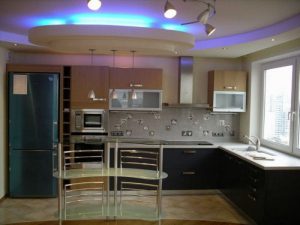
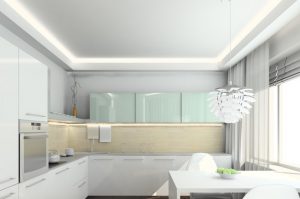
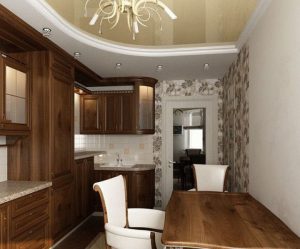
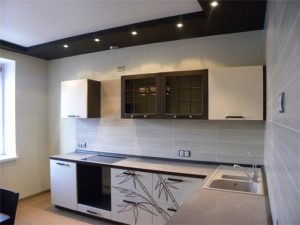
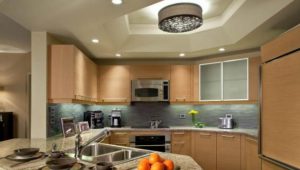
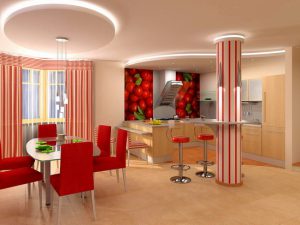

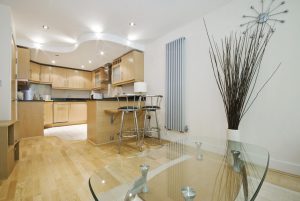
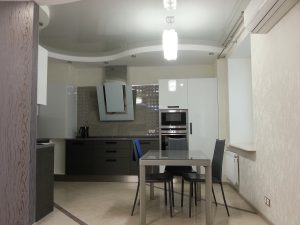

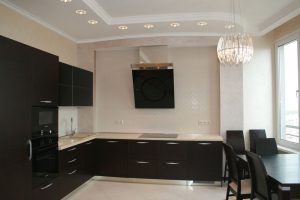
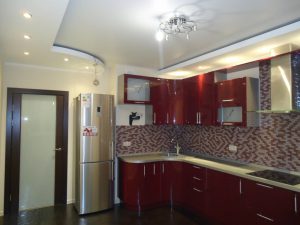
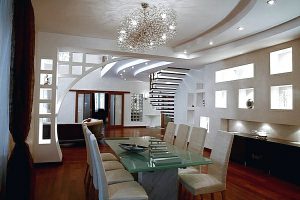
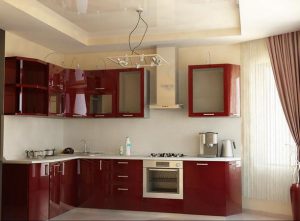
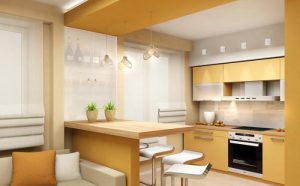

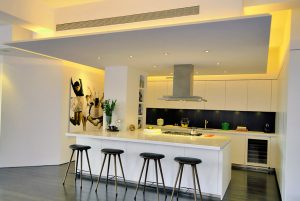



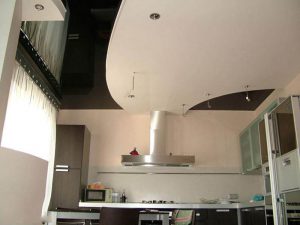
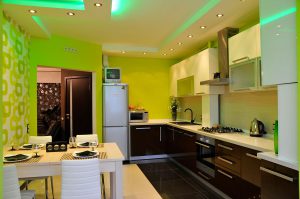
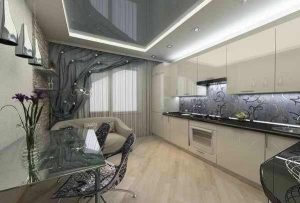
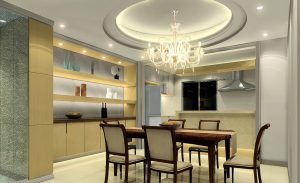
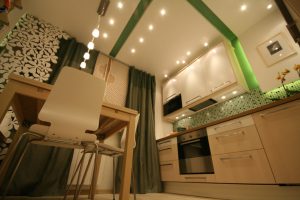
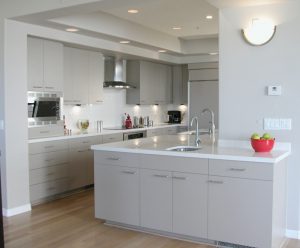
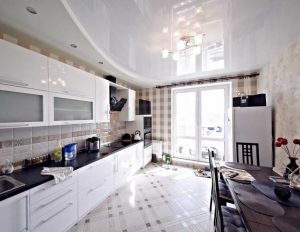

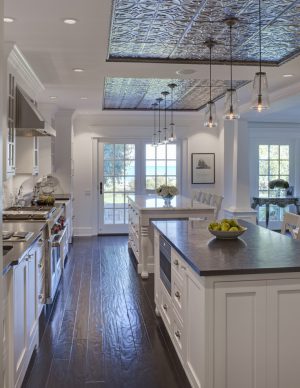
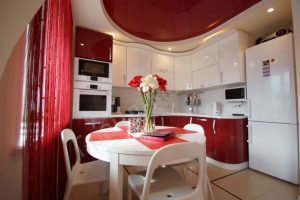
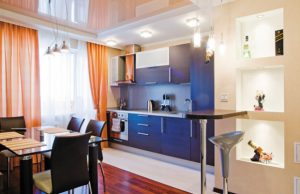
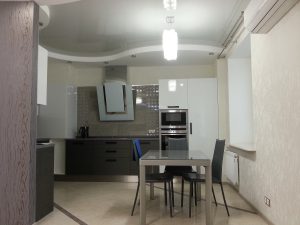
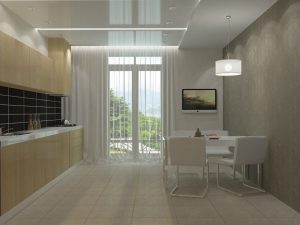
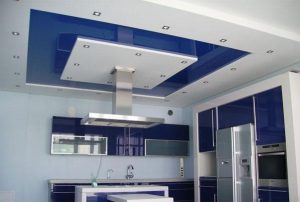
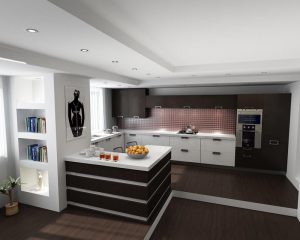
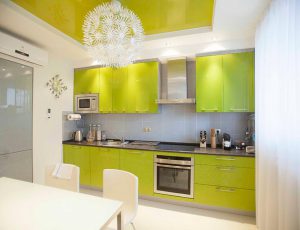
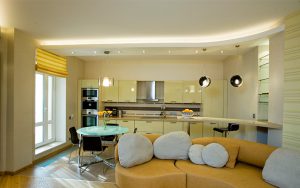
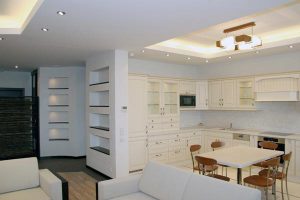

05.05.2023 @ 18:46
itchen
Si les dalles de plafond dans la cuisine sont de niveaux différents et présentent également des fentes et des irrégularités, lutilisation de plafonds en plaques de plâtre sera la solution la plus réussie. De plus, cela aidera à résoudre les problèmes liés à la pose des communications, et vous aurez la possibilité de créer un schéma déclairage intéressant. De plus, il est possible de former les designs les plus divers de plafonds en plaques de plâtre dans la cuisine – ovales, droits, courbés et même ronds. Les plafonds en plaques de plâtre dans la cuisine se combinent parfaitement avec tous les styles dintérieur et peuvent être utilisés pour résoudre divers problèmes dordre technique ou esthétique. Les avantages incluent la résistance à lhumidité, la résistance aux changements de température, la facilité dinstallation et lisolation thermique et acoustique. Les inconvénients incluent le risque de formation de fissures si linstallation nest pas effectuée correctement et la nécessité dune peinture soignée pour cacher les joints. En fin de compte, les plafonds en plaques de plâtre sont une option viable pour la cuisine.